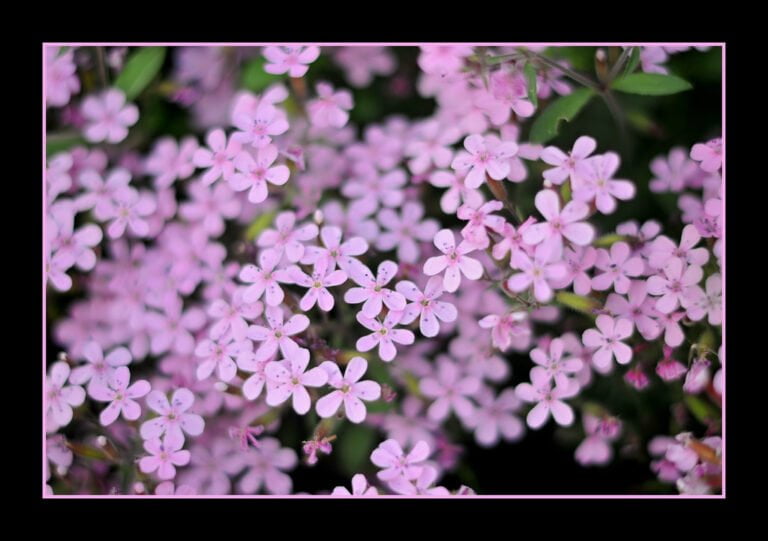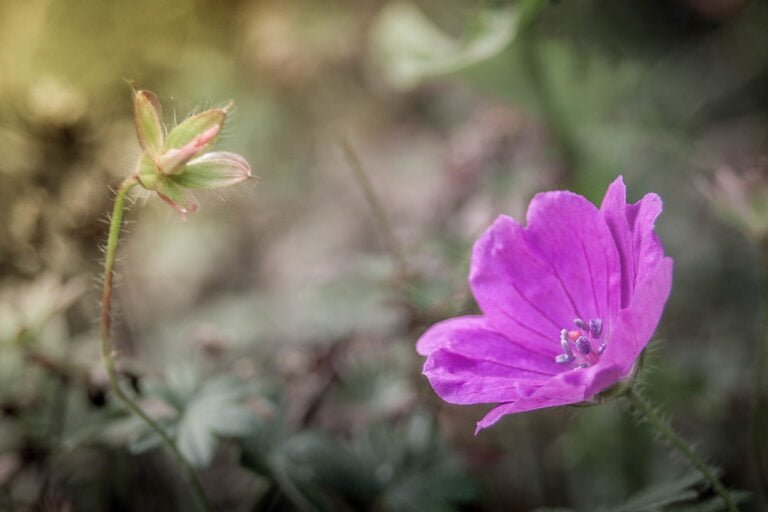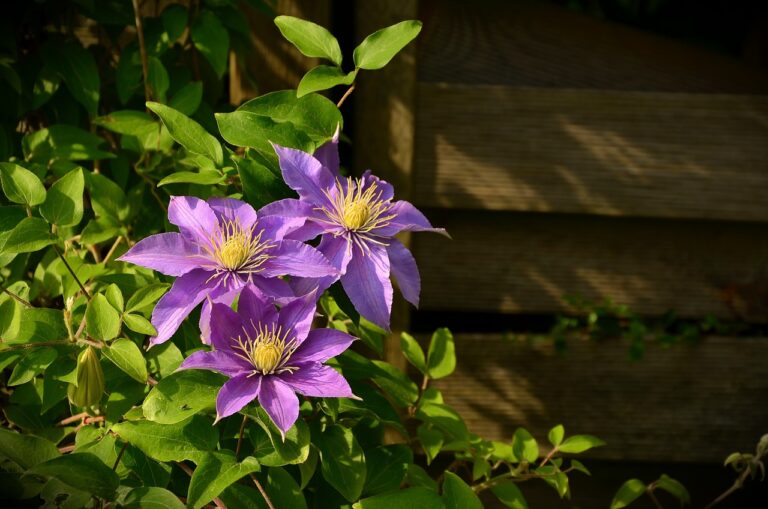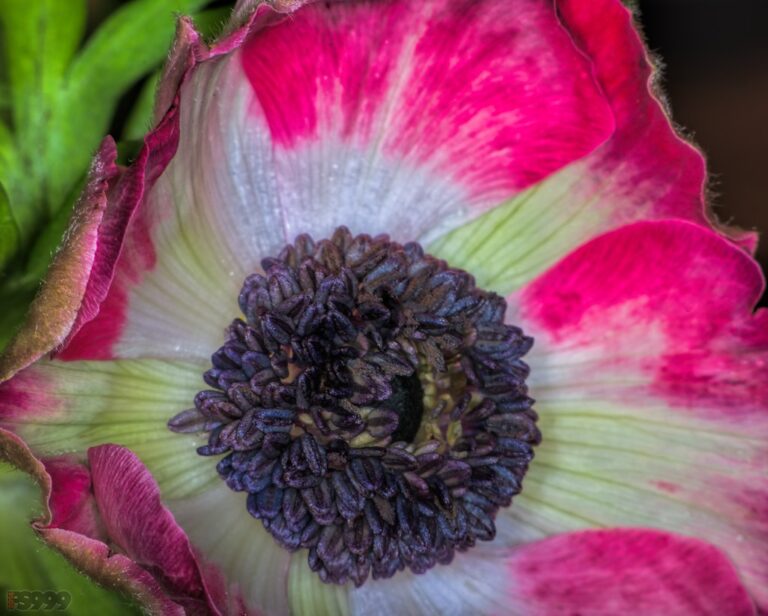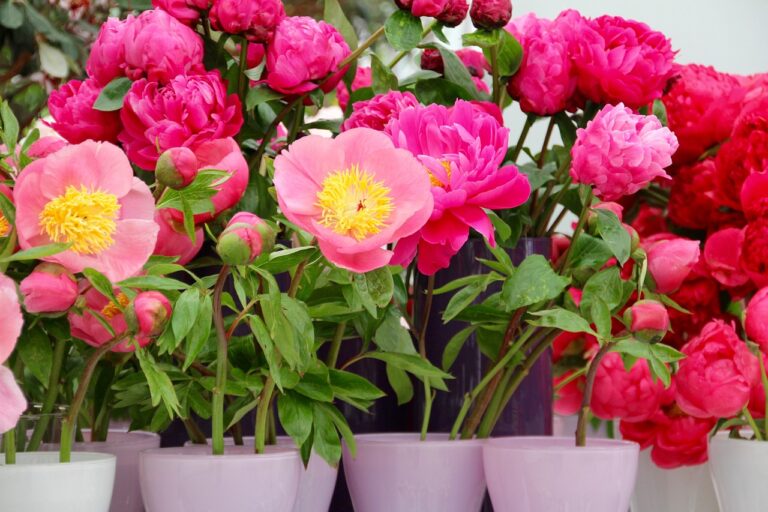Exploring Climbers With Purple Flowers: Types and Care Tips
Purple flowered climbers like Clematis, Morning Glory, Wisteria, Bougainvillea, and Passion Flower add vibrancy and height to gardens. Plant in full sun with pruning and pest control as key care steps. Top choices include Blue Sky Vine, Bougainvillea, Clematis, Dutchmans Pipe, and Hyacinth Bean Vine for variety. Passion Flower and Morning Glory prefer sunlight and well-draining soil. Support with trellises and monitor for pests. Successful growth hinges on sunlight, moisture levels, and pruning. Discover more about purple climbers for a thriving garden.
Purple Flowered Climbers Overview
Purple flowered climbers, such as Clematis, Morning Glory, Wisteria, Bougainvillea, and Passion Flower, are beloved for their vibrant blooms that can reach heights ranging from 6 feet to 40 feet, adding a striking burst of color to any garden setting. These enchanting vines not only provide a visual feast but also offer a vertical dimension to gardens, making them ideal for covering pergolas, trellises, fences, or any vertical structure that needs a touch of purple magnificence.
In terms of care, these purple flowering vines flourish best when planted in areas that receive full sun, although some species can tolerate partial shade. Regarding pruning, it is crucial to understand each plant’s specific requirements. Regular pruning helps maintain their shape, control growth, and promote better flowering. Deadheading spent blooms can also stimulate new flower production and tidy up the overall appearance of the vine. Additionally, keeping an eye out for pests and diseases is essential to maintain the health and vitality of these climbers. By following these simple yet important care tips, you can enjoy a cascade of purple blossoms adorning your garden throughout the growing season.
Best Purple Flowered Climbing Plants
I’ve compiled a list of the best purple flowered climbing plants that are sure to beautify any garden space. These climbers, such as Blue Sky Vine, Bougainvillea, Clematis, Dutchmans Pipe, and Hyacinth Bean Vine, offer a range of sizes and sun exposure preferences. By incorporating popular choices like Morning Glory, Star Jasmine, Passion Flower, and Wisteria, you can create a vibrant and colorful garden with proper care and attention to their specific needs.
Popular Purple Climbers
Adding a touch of elegance and vibrancy to your garden, these popular purple climbers boast stunning blooms that range from deep shades to delicate hues.
- Clematis: Known for its star-shaped flowers and versatility in garden design.
- Wisteria: Impressive climbing plant with cascading purple flower clusters.
- Morning Glory vine: Delicate blooms that add a pop of color to any trellis.
- Bougainvillea: Vibrant purple flowers that can grow to impressive heights.
- Passion Flower: Intricate blooms in shades of purple that attract pollinators.
These climbers not only provide visual interest but also attract beneficial wildlife to your garden. Careful maintenance guarantees healthy growth and abundant blossoms for a picturesque outdoor space.
Climber Care Tips
To guarantee the healthy growth and abundant blossoms of your purple flowered climbing plants, it is imperative to follow specific care tips tailored to their unique needs and requirements. Purple flowering climbers such as Clematis and Wisteria thrive best in full sun to partial shade conditions. Regular pruning is vital to maintain their health and appearance. Providing adequate support structures like trellises or arbors is necessary for their upward growth. Purple flowering vines like Passion Flower and Morning Glory prefer well-draining soil with ample sunlight for best blooming. Monitoring these climbers for pests and diseases regularly is crucial to ensure their longevity and vitality. By following these care tips, you can enjoy a stunning display of purple flowers climbing gracefully in your garden.
Care Tips for Purple Flowered Climbers
When tending to purple flowered climbers, it’s important to pay attention to their soil and watering needs. Ensuring they are planted in well-draining soil can prevent root rot and promote healthy growth. Additionally, monitoring sunlight exposure and regular pruning are essential for maintaining the health and vibrancy of these climbers.
Soil and Watering
Purple flowered climbers thrive best when planted in well-draining soil that prevents waterlogging and root rot. To guarantee their health and vigor, proper soil moisture and watering practices are essential. Here are some care tips for maintaining these climbers:
- Regular Watering: Keep the soil consistently moist but avoid waterlogging.
- Adjust Watering Frequency: Monitor weather conditions and adapt watering accordingly for best growth.
- Mulching: Mulch the base of the climbers to retain soil moisture and regulate temperature.
- Avoid Overwatering: Prevent waterlogging by ensuring good drainage in the soil.
- Promote Health: Implement these practices to maintain the health and vigor of your purple flowered climbers.
Sunlight and Pruning
Ensuring adequate sunlight exposure and consistent pruning are essential practices for maintaining the health and beauty of purple flowered climbers. Purple flowered climbers typically thrive in full sun to partial shade, depending on the specific plant species. It is crucial to research the individual pruning requirements of different purple flowered climbers to guarantee they are pruned correctly. Regular pruning is vital for keeping these climbers healthy and in good condition. By employing proper pruning techniques, such as removing dead or overgrown branches, you can promote new growth and improve flowering. Sufficient sunlight and regular pruning are key factors in ensuring that purple flowered climbers not only survive but also thrive, creating a stunning display in your garden.
Growing Purple Flowered Vines Successfully
Growing purple flowered vines successfully involves understanding their specific care requirements and providing the right balance of sunlight and water for ideal growth. Purple flowered vines, such as Clematis and Wisteria, can reach heights of up to 30 feet, making them a striking addition to any garden landscape. To make sure these vines thrive, here are some key points to keep in mind:
- Choose the Right Location: Plant purple flowered vines in areas that receive full sun to partial shade, as this will help them flourish and produce abundant blooms.
- Provide Adequate Water: While these vines have specific water needs depending on the variety, it’s important to keep the soil consistently moist but not waterlogged to support healthy growth.
- Support Pruning Practices: Regular pruning is essential for maintaining the overall health and shape of purple flowered vines, promoting new growth and enhancing flowering.
- Attract Beneficial Pollinators: Purple flowering vines are known to attract beneficial pollinators like butterflies and bees, contributing to a thriving ecosystem in your garden.
- Customize Care: Understanding the individual sunlight and water requirements of each purple flowering vine variety is key to growing them successfully and making sure they reach their full potential.
Pruning Techniques for Purple Flowered Climbers
Understanding the best timing for pruning purple-flowered climbers like Clematis and Wisteria plays an important role in maintaining their health and blooming potential. Pruning these climbers should ideally be done after flowering to prevent cutting off next season’s blooms. When pruning, it is crucial to remove dead or damaged stems to promote new growth and promote the overall health of the plant. By cutting back overgrown vines, you can control the size and shape of the climber, allowing for proper airflow and sunlight penetration, which are essential for healthy growth.
To maintain healthy growth and prevent tangling, it is advisable to prune back lateral shoots. This technique encourages vertical growth and helps in keeping the climber well-structured. Regular pruning is key to ensuring that purple-flowered climbers remain vigorous and bloom profusely each season. By following these pruning techniques, you can help your purple-flowered climbers thrive and improve the beauty of your garden. Keep in mind that different climbers may have specific pruning requirements, so it’s crucial to research the particular needs of the plants you are growing.
Supporting Purple Flowered Climbing Plants
When supporting purple flowered climbing plants, selecting sturdy trellises, arbors, or fences is essential to uphold their weight effectively. These structures not only provide support but also improve the aesthetic appeal of the garden. Additionally, incorporating a support system with horizontal and vertical wires can help vines like Clematis climb and flourish efficiently. Here are some practical tips for supporting vines with purple flowers:
- Regular Pruning: Purple flowering vines such as Bougainvillea may require regular pruning and shaping to maintain their desired growth pattern. Pruning helps promote new growth and keeps the plant in optimal health.
- Metal or Wooden Stakes: In windy conditions, metal or wooden stakes can provide additional support for fast-growing vines like Morning Glory. These stakes anchor the plant securely and prevent it from swaying excessively.
- Ample Sunlight: Providing ample sunlight is critical for the healthy growth and climbing habit of purple flowered vines like Star Jasmine. Placing them in sunny spots allows them to photosynthesize effectively and bloom vibrantly.
- Well-Draining Soil: Ensuring the plants are in well-draining soil is essential for their overall health. Poorly drained soil can lead to root rot and other issues, affecting the plant’s ability to climb and thrive.
Dealing With Pests and Diseases in Climbers
Examining climbing plants with purple flowers regularly for signs of pests and diseases is vital for maintaining their health and vitality. Pests such as aphids, spider mites, and caterpillars can wreak havoc on these plants, while diseases like powdery mildew, leaf spot, and root rot can also pose significant threats. To combat these issues, early detection is key. Regular inspections can help in identifying problems at their onset, allowing for prompt treatment.
When it comes to managing pests on climbing plants with purple flowers, organic solutions are highly recommended. Products like neem oil or insecticidal soap can effectively control pests without causing harm to beneficial insects or the environment. These natural remedies offer a gentle yet potent way to address pest infestations.
In addition to pest management, preventing diseases is equally important. Good watering practices, proper air circulation around the plants, and maintaining cleanliness can go a long way in reducing the risk of diseases like powdery mildew and leaf spot. By adopting these preventive measures, you can create a healthier environment for your climbing plants, ensuring they thrive and display their beautiful purple flowers to their full potential.

